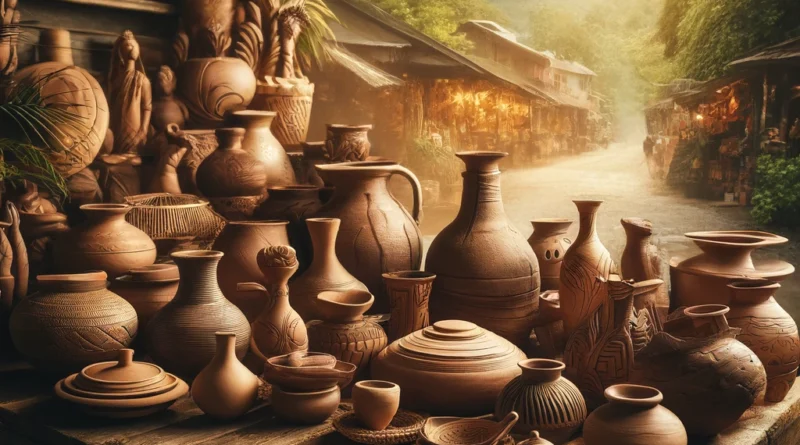Unveiling the Hidden Gem: Clay Products in Jamaica
People are aware of Jamaica for its lively traditions and rich landscape. One that needs more attention is this Caribbean island’s centuries-old clay craft tradition. From meticulously adorned sculptures as works of art to basic utensils, clay products from Jamaica are a benchmark of creativity. Every item is a masterpiece showcasing the island’s cultural multiplicity and the talent of local artisans, which makes them very useful as well as priceless. Jamaican clay products aren’t just ordinary; they are extraordinary.
Both the finished product and its creation make this masterpiece a work of art. It means taking in the island’s geographic features, having immense patience, and possessing sophistication. The result is classic, unique artifacts that truly capture the spirit of the land.
This article will discuss the important events and social influences regarding Jamaican clay works and the spots in Jamaica where these exquisite masterpieces are located within the thick stretches of greenery and beauty. So, let’s delve deeper into the beauty of Jamaican clay crafts.
Many islands are unique in their way, but Jamaica is rich in many cultures, fascinating history, and artistic beauty. In addition, local artisans craft intricate clay products, a visual delight. The treasures in Jamaica are truly special. The people on the island have these clay artifacts beautifully crafted into different forms that also serve purposes.
This is where the history of Jamaica begins. For several generations, the locals were able to maintain the art of crafting and clay making. The people use the resources abundantly available to them to create eco-friendly products. The Austral locals are proud to be able to offer such wonderful green products to the world.
The Jamaican pottery consists of a variety of items. The items range from basic household items like pots and vases to more elaborate pieces of art. The detailed painting of the numerous products is a combination of nature along with Jamaican culture, which serves as inspiration. Each crafted piece is beautiful, combining practicality and artistry.
This article invites you to appreciate the intricately made pieces of Jamaica. The exclusives of Jamaica are their clay artifacts that exude creativity and artistry. Let us explore this together.
THE INCEPTION OF CLAY ARTIFACTS IN JAMAICA
The inception of clay artifacts in Jamaica dates back many centuries and is an intricate part of the culture of the nation. The natives primarily used the artisanal Jamaican clay, molding it into tools and other useful vessels. The new powers that emerged during the colonization phase altered the traditional practices of the island.
The advent of pottery and ceramic industries developed in tandem with the history of the nation. African, Spanish, and British traditions transformed the local art, giving rise to an impressive multitude of exceptional styles. Today’s pieces beautifully capture this blend in their patterns and motifs.
Sculpting with clay and pottery making have been part and puzzle of a Jamaican’s life for ages, practically essential for the existence of the people. The natives traditionally used clay pots for cooking and other household chores. Ultimately, they became beautiful pieces that showcased the culture of the islands and its people. In Jamaica, claycraft never lost its appeal because it blends modern concepts with old traditional craftsmanship.
Pottery and sculptures in Jamaica.
In Jamaica, pottery making has gained immense popularity, which has also allowed for the creation of products such as figurines, pots, and trinkets whereby the local artisans are skilled enough to shape Jamaican clay into impactful art pieces.
In Jamaica’s culture, the fine arts as well as craftwork have always placed special emphasis on the history and heritage of the land. Hand-painted masonry gourd artifacts, including vases, bowls, and deeper-shaped figurines known as idol pots, narrate fascinating stories about the locality. Every piece of pottery has its tale inscribed onto it using various techniques, such as sculpting onto ceramic tiles alongside tiles that decorate gardens and houses. The vibrant colors of nature truly reflected within the Jamaican pottery. Gardening can boast these sculptures, while the rest can decorate dull rooms and add vibrancy to the house or the surroundings. These portraits of beauty, along with the traditional painting techniques used, serve to practically augment the traditional pottery. Every masterpiece not only offers visual pleasure but also serves multiple purposes. These earthy and captivating sculptures bring the island narrative and cultural history of the vibrant and lush landscapes to life. Moreover, artisans use clay pottery to share the island’s unique story while saving its heritage. Construction Materials In Jamaica, clay not only enhances beauty but also plays a crucial structural role. Local bricks, tiles, and paving stones made of Jamaican clay are highly durable and excellent in quality. Moreover, these materials are highly sustainable and could serve as an eco-friendly alternative to regular building materials; this change could contribute to better architecture.
Clay serves an important role in heat insulation and energy conservation in structures. Local clay is unique because of its texture, and its contribution to the buildings is even more amazing. Due to the increased concern about building sustainably, clay continues to be one of the main raw materials for green building in Jamaica.
Crafts and jewelry
Jamaican artists are creative with clay and transform it into beautiful works of art— from jewelry to surreal sculptures to exquisite pottery. Those who make jewelry out of Nichol’s rock clays fully appreciate the vivid designs that capture the cherished motifs of the mysterious island. These sculptural jewelry pieces are lovely souvenirs from Jamaica.
Clay crafts are perfect souvenirs because they are cheap and artistic. They are also supportive of the local people and make fantastic presents. This is a growing industry because it captures the essence of modern marketing while still keeping the beauty of olden craftsmanship. We consider each piece to be a unique work of art.
Key regions and artisans specializing in clay
Jamaica has several important regions containing clay works, and each one has a different character and technique. Many craftsmen draw inspiration from nature in the Blue Mountains region.
Clay is readily available in this region and is a crucial material for crafting both functional and decorative articles.
Every artisan on the island is a master in their craft with their individual set of skills, which they have been perfecting for a long time. For example, St. Ann and Clarendon are some of the places where one can find traditional pottery making because these locations integrate old and new techniques. These craftsmen form the backbone of the clay industry in Jamaica, reproducing heritage through a myriad of expressive clay forms.
Importance of clay in Jamaican culture
Clay forms an integral part of Jamaican culture; it is above all highly utilitarian. It is the substance and material that links Jamaica’s people to their ancestors and heritage. It is key since it also guarantees that traditional practices are continued. For a Jamaican, clay artifacts are vital for both everyday and ceremonial practices as they demonstrate the various aspects of life on the island.
Some of them, such as the Jabba pot or even coal stoves, are used during many different kinds of ceremonies and, of course, have enormous historical significance. Through this medium, these craftsmen are able to convey a message that is empowering.
Every artifact crafted from Jamaican clay captures the heart of the island and mirrors the love for aesthetic art and the creativity of its people.
Emerging Trends in Jamaican Clay Products
There is a lot happening in the Jamaican clay industry as artisans mesh age-old techniques with contemporary finesse. Artists are experimenting with various styles, such as multimedia and digital transformations, to modify the design of clay objects. These techniques give life to the new designs and make them appealing to the global market.
New friends are also gaining footing. Artisans are demonstrating great concern for environmental issues by adopting eco-friendly materials and methods. Their Jamaican clay style, which is distinct, remains unaffected, and this is the target of Jamaican artists and their foreign counterparts. These innovations help broaden the set audience of Jamaican ceramics while protecting cultural heritage.
Challenges Facing The Jamaican Clay Sector
Despite the fondness that Jamaica has for its rich heritage, there are some problems in the clay industry. One of the most troubling problems is the lack of materials, which is a threat to sustainability. Artisans sometimes find it difficult to access raw materials of reasonable quality to create finished products.
Also, the competition increases with the introduction of imports, which makes it difficult for local competitors. Modernization compounds this challenge by placing pressure on more traditional techniques. While support for small businesses and fair trade is crucial, government and financial institutions relevant to this area unfortunately tend to be lacking in support. We must address these issues to safeguard and enhance the legacy and skills of clay craftsmen in Jamaica.
To conclude
The clay artifacts from Jamaica serve as a glimpse of the stunning, rich culture that the island has to offer. These crafts transcend beauty, skill, and history. It is pure art. With complete creativity and respect for their ancestors, artisans create unique, strong clay products. These items contribute to the formation of society and the preservation of culture. Every visitor to Jamaica, and even locals, have to get their hands on it. It is advisable to make a special effort to search for clay artifacts in order to maximize tourism activities in Jamaica. Consider looking for local markets and even workshops. These items are more than just clay artifacts; they have a soulmate.




